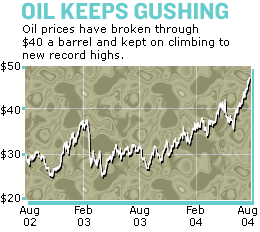NEW YORK (CNN/Money) -
With the price of oil hitting records nearly every day, a handful of analysts think the market is starting look awfully bubbly, and that the price could correct quickly.
Thursday brought yet another record in the price of a barrel of crude oil, which fetched about $48 on the New York Mercantile Exchange. It was only a couple of weeks ago that analysts were making bold projections of $50 oil. Now there's talk of it breaking $60.
Oil has skyrocketed some 55 percent in the past year, and a small number of analysts believe that most, if not all, of that gain has been unjustified.
"We continue to believe oil prices will fall hard," Bear Stearns analyst Frederick Leuffer wrote in a note to clients this week. "We forecast an average ... oil price of $25 per barrel in 2005."
Not long ago, that was a consensus forecast. Now it's in the distinct minority.
Most analysts now believe higher prices are justified, citing higher-than expected demand for oil in the world, tight supplies, a higher risk of terror attacks and a growing difficulty in sucking a dwindling supply of oil out of the ground.
Leuffer isn't buying it. In his note, he makes a step-by-step case about why he believes the consensus is wrong.
Yes, global demand is high, he wrote, but it's being exceeded by supply. The evidence is in inventories, which continue to grow around the world, including the United States. The current level of global inventory, about 300 million barrels, is consistent with oil at about $25 per barrel, according to Bear Stearns' research.

"Since January 2004, the correlation between crude oil prices and inventory levels has broken down," Leuffer wrote.
Fear about tight production capacity is also unjustified, he wrote. The Organization of the Petroleum Exporting Countries (OPEC), which accounts for about 40 percent of the world's oil output, has some 2.1 million barrels per day of excess production capacity, according to Leuffer's estimates, on top of the 2.7 million per day it's already generating in excess of demand.
What's more, non-OPEC supply is higher than ever, and he thinks oil companies are having an easier time getting oil out of the ground than is widely believed.
Leuffer also said that terror attacks and sabotage likely won't cause much of a disruption of the world's oil supply; they haven't in the past.
The troubles of Yukos, Russia's largest oil company, won't affect supply because the Russian government won't allow it, he said -- Russia needs the cash that Yukos' oil generates.
A few other analysts agree with his view that the oil market has begun to bear a striking resemblance to the bubbly tech-stock market of the late 1990s.
"Rumors and speculation have taken over the market," Oppenheimer analyst Fadel Gheit told CNN/Money this week.
Not so sanguine
But most analysts do not.
They agree that there is a hefty "fear premium" built into the price of oil, keeping the price perhaps $10 or more higher than where supply and demand would indicate.
| Related stories
|

|
|
|
|
But they don't believe the market can simply afford to remove that premium.
Terror attacks and sabotage could cause significant disruption, depending on where they take place, and traders have to get some insurance for that possibility.
"In a perfect world, you'd take the premium out, and you're looking at an oil price in the lower- to mid-30s," said Bruce Lanni, an analyst with A.G. Edwards & Sons. "But it is not a perfect world."
Most analysts aren't as certain as Leuffer is about OPEC's ability to pump much more oil, or the ease of finding new oil supplies.
Nor do they believe that world inventories are high enough to keep up with skyrocketing demand, particularly in fast-growing markets such as China and India.
"If you take a look at the supply-demand fundamentals in the world, there's not a lot of excess supply available or much coming on line," said Jacques Rousseau, an analyst with Friedman Billings Ramsey.
Oil prices, adjusted for inflation, aren't as high as they were in, say, the late 1970s and early 1980s, when they rose to the equivalent of $80, in today's dollars,
after the Iranian revolution and subsequent Iran-Iraq war. Partly for that reason, most economists doubt a global recession will result from the recent spike.
But this is a mixed blessing -- the limited damage being done to the world's biggest economies means demand is not suffering much, OPEC said this week -- which in turn means that oil prices have some support.
Meanwhile, after ratcheting up their capacity to suck more oil out of the ground in the 1970s and 1980s, oil companies haven't kept accelerating their capacity growth in recent years, according to George Gaspar, an analyst at Robert W. Baird & Co.
"I don't think the industry has the capacity to expand much beyond the rate at which it's expanding now," Gaspar said. "When you match a relatively constrained capacity to expand against the increasing growth rate of demand for crude oil, it sets the potential course for oil to ultimately go beyond $50 a barrel."

|

